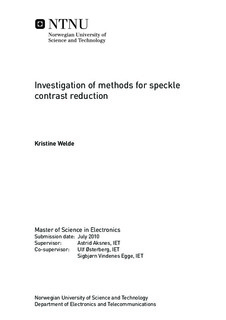Investigation of methods for speckle contrast reduction
Abstract
Speckle arises when coherent light is reflected from a rough screen and observed by an intensity detector with a finite aperture. Because speckle causes serious image degradation when lasers are used as light sources in e.g. projectors, methods for reducing the speckle contrast need to be developed. Different speckle contrast reduction methods are investigated in this thesis, such as a rotating diffuser and a sinusoidal rotating grating. In addition, speckle simulations with the optical system design software ZEMAX has been explored. A setup consisting of a 4-f imaging system with a rotating diffuser in the Fourier plane was developed in order to decide whether or not it is advantageous to perform speckle reduction in the Fourier plane. Hence, measurement series were performed with the rotating diffuser placed at different positions in the 4-f imaging system for comparison. Measurement series were executed both with an empty object plane and with a lens in it to spread the light in the Fourier plane. Placing a rotating diffuser in the Fourier plane does not appear to be effective for speckle contrast reduction. The last setup investigated was a transmissive spatial light modulator (SLM) placed in the beam path. Sinusoidal rotating gratings created by means of gray levels, to simulate a potential modulator based on a deformable polymer layer, were implemented on the SLM. The gratings were rotated around their centers, and in a spiral in order to reduce the speckle contrast. For the first method the modulator speckle contrast was 34% for N = 18 averaged images, and for the second method it was 31% for N = 36 averaged images, both with a grating period of 4 pixels. Due to the drawbacks of the SLM optimal results were not achieved, but the SLM is useful for a proof-of-concept. Further measurements should be performed for this promising, novel method based on a true sinusoidal grating.
